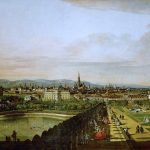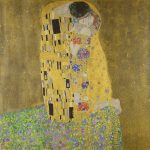In the golden glow of Vienna’s Fin de siècle, a time brimming with artistic innovation and cultural transformation, the names Gustav Klimt and Emilie Flöge emerge as central figures. Their relationship, woven through the fabric of both personal affection and professional collaboration, offers a captivating narrative of lifelong friendship, creative partnership, and the tantalizing possibility of romance. Let’s explore the intricate dynamics of their bond, its impact on their respective works, and the legacy they left behind.
Meeting of Minds: The Genesis of a Lifelong Bond
Gustav Klimt, born in 1862, and Emilie Flöge, born in 1874, were introduced through Klimt’s brother Ernst, who was married to Emilie’s sister Helene. This familial connection brought them into each other’s orbits, and what began as a casual acquaintance quickly blossomed into a deep and enduring friendship.
Klimt, a founding member of the Vienna Secession movement, was already an established artist known for his distinctive style that blended symbolism, eroticism, and the decorative arts. Emilie, on the other hand, was carving her own niche in the fashion world, eventually becoming a prominent designer and businesswoman. Their shared interests in art and aesthetics naturally drew them together, fostering a relationship that transcended the conventional boundaries of friendship.
One of the most significant aspects of Klimt and Flöge’s relationship was their artistic collaboration. Klimt’s work, renowned for its opulent use of gold leaf and intricate patterns, often featured clothing and fabrics that bore a striking resemblance to the designs created by Flöge. As a fashion designer, Flöge was a pioneer in reforming women’s dress, advocating for more comfortable and practical garments that contrasted sharply with the restrictive fashions of the time.
Klimt’s paintings, particularly his portraits, frequently showcased these innovative designs. One of the most iconic examples is the portrait of Emilie Flöge herself, painted in 1902. In this portrait, Emilie is adorned in a flowing, patterned dress that epitomizes her design ethos and Klimt’s aesthetic sensibilities. This synergy between Klimt’s art and Flöge’s fashion underscores the deep mutual influence they had on each other’s creative processes.
Their collaboration extended beyond individual works to a broader shared vision of beauty and modernity. Both Klimt and Flöge were part of a progressive cultural milieu that sought to break free from traditional constraints and explore new artistic expressions. The Vienna Secession, co-founded by Klimt, was a manifestation of this desire for innovation, and Flöge’s fashion designs echoed this spirit of rebellion and creativity.
Their bond, thus, was not just personal but also ideological. They were united by a common goal of pushing boundaries and redefining the artistic and cultural landscape of their time. This shared vision cemented their relationship, making it a cornerstone of Vienna’s artistic avant-garde.
Beyond Friendship: The Question of Romance
While the depth of their friendship is well-documented, the nature of Klimt and Flöge’s relationship has long been a subject of speculation. Did their bond transcend friendship and venture into the realm of romance? This question has intrigued historians and art enthusiasts alike, adding a layer of mystery to their story.
Klimt’s personal life was notoriously complex. He was known for his numerous romantic liaisons and had fathered several children with different women. Despite his reputation as a libertine, his relationship with Flöge stood apart. Unlike his other relationships, which were often fleeting and purely physical, his bond with Flöge was characterized by emotional depth and intellectual compatibility.
Klimt’s letters to Flöge, though not overtly romantic, reveal a deep affection and respect. He often referred to her as his closest confidante and shared his innermost thoughts and feelings with her. These letters, along with their frequent travels together and the significant amount of time they spent in each other’s company, suggest a bond that was both profound and enduring.
Emilie Flöge, for her part, remained unmarried throughout her life. Her close relationship with Klimt was often viewed with suspicion by those around them, who speculated about the true nature of their bond. However, Flöge was fiercely independent and dedicated to her career, traits that were atypical for women of her time.
While Flöge never publicly acknowledged a romantic relationship with Klimt, her loyalty to him and her role as his muse suggest a deep emotional connection. The ambiguity surrounding their relationship adds to the intrigue, leaving room for interpretation and speculation.
Whether romantic or purely platonic, the nature of Klimt and Flöge’s relationship undeniably influenced their work. Klimt’s portrayal of women, characterized by a blend of sensuality and reverence, can be seen as a reflection of his complex feelings for Flöge. Similarly, Flöge’s designs, with their emphasis on freedom and individuality, mirror the progressive ideals that defined her bond with Klimt.
Their collaboration and mutual influence enriched their respective artistic practices, making their relationship a source of creative inspiration and innovation. This interplay between personal affection and professional collaboration is a testament to the depth and complexity of their bond.
The Creative Synergy: Fashion and Art Intertwined
Klimt and Flöge’s relationship is a prime example of how personal connections can foster creative synergy. Their partnership transcended the boundaries of their individual disciplines, resulting in a unique fusion of fashion and art.
Emilie Flöge was a trailblazer in the fashion world. Along with her sisters, she founded the couture salon Schwestern Flöge (Flöge Sisters) in Vienna, which became a hub for avant-garde fashion. Her designs were influenced by the reform dress movement, which advocated for looser, more comfortable clothing that allowed for greater freedom of movement.
Flöge’s innovative designs were a stark departure from the corseted silhouettes that dominated women’s fashion at the time. She introduced loose-fitting dresses with flowing lines and bold patterns, often inspired by Klimt’s art. This cross-pollination of ideas between Klimt’s paintings and Flöge’s fashion resulted in a distinctive aesthetic that was both modern and timeless.
Klimt’s artistic style, characterized by its decorative richness and symbolic depth, was profoundly influenced by his relationship with Flöge. The flowing lines and intricate patterns of Flöge’s dresses can be seen in Klimt’s paintings, particularly in his portraits of women. This visual dialogue between fashion and art highlights the creative synergy that defined their partnership.
One of the most striking examples of this interplay is Klimt’s famous painting, “The Kiss.” The depiction of the couple, enveloped in a golden embrace, showcases Klimt’s signature ornamental style, which bears a strong resemblance to Flöge’s fashion designs. The intricate patterns and luxurious fabrics in the painting echo the aesthetics of Flöge’s creations, underscoring the deep connection between their artistic visions.
Both Klimt and Flöge were integral to the Vienna Secession movement, which sought to break away from traditional artistic conventions and explore new forms of expression. The movement’s motto, “To every age its art, to every art its freedom,” encapsulates the spirit of innovation and experimentation that defined their work.
Klimt’s role as a leader of the Vienna Secession and Flöge’s pioneering efforts in fashion were mutually reinforcing. Their collaboration and shared ideals contributed to the movement’s success, making it a defining moment in the history of modern art and design. Their partnership not only enriched their individual practices but also left a lasting impact on the cultural landscape of Vienna and beyond.
Legacy and Influence: Enduring Impact
The relationship between Gustav Klimt and Emilie Flöge, whether viewed through the lens of friendship or romance, left an indelible mark on their respective fields. Their creative synergy and mutual influence continue to inspire artists and designers to this day.
Gustav Klimt’s legacy as one of the most influential artists of the 20th century is well-established. His distinctive style, characterized by its ornamental richness and symbolic depth, has left a lasting impact on the world of art. The emotional intensity and decorative beauty of his work continue to captivate audiences, making him a central figure in the history of modern art.
Klimt’s portraits of women, many of whom were inspired by Flöge, remain some of his most celebrated works. These portraits, with their intricate patterns and sensual elegance, reflect the profound influence of his relationship with Flöge. The combination of artistic innovation and emotional depth in Klimt’s work ensures his enduring relevance and appeal.
Emilie Flöge’s contributions to fashion, though less widely recognized than Klimt’s contributions to art, are equally significant. Her innovative designs and advocacy for women’s dress reform were ahead of their time, laying the groundwork for modern fashion. Flöge’s emphasis on comfort, freedom, and individuality in her designs challenged the restrictive norms of her era and paved the way for future generations of designers.
Today, Flöge is celebrated as a pioneer in the world of fashion. Her influence can be seen in the continued evolution of women’s clothing, with her ideas about comfort and self-expression resonating in contemporary design. Exhibitions and retrospectives of her work have brought renewed attention to her contributions, highlighting her role as a key figure in the history of fashion.
The nature of Klimt and Flöge’s relationship remains one of the most intriguing aspects of their story. The ambiguity surrounding their bond adds a layer of mystery and allure, inviting endless speculation and interpretation. This enduring mystery keeps their story alive, capturing the imagination of art and fashion enthusiasts alike.
Their relationship, whether romantic or platonic, serves as a powerful example of how personal connections can influence creative expression. The interplay between Klimt’s art and Flöge’s fashion, shaped by their deep bond, continues to inspire and captivate, ensuring their place in the annals of cultural history.
A Timeless Bond
The story of Gustav Klimt and Emilie Flöge is one of enduring friendship, creative collaboration, and the tantalizing possibility of romance. Their relationship, marked by mutual respect, shared ideals, and artistic synergy, transcended the conventional boundaries of friendship and partnership. It was a bond that enriched their lives and work, leaving a legacy that continues to inspire and captivate.
As we reflect on their story, we are reminded of the profound impact that personal connections can have on artistic expression. Klimt and Flöge’s partnership, characterized by its depth and complexity, serves as a testament to the power of collaboration and the enduring influence of shared vision. Their legacy, woven through the fabric of art and fashion, remains a timeless source of inspiration and fascination.




